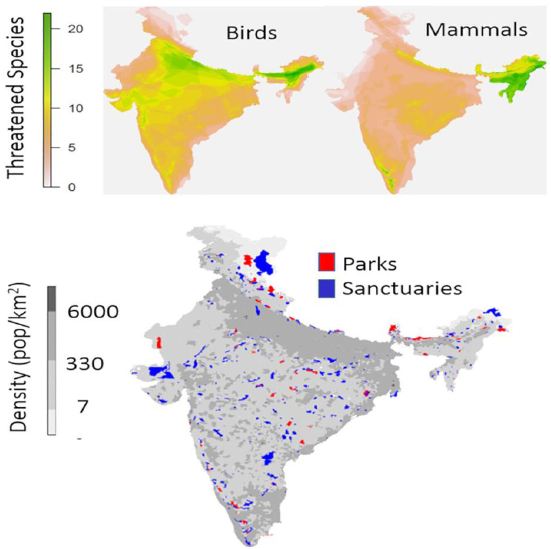Study of Biodiversity Areas for Conservation in India
DOI:
https://doi.org/10.5281/zenodo.10654918Keywords:
biodiversity, environmental, national park, northeast area, protectionAbstract
Three broadly accepted claims in conservation biology are that the world's developing tropical countries will see the largest declines in biodiversity in the near future, that these regions are among the least studied globally, and that local community support is particularly important for protection in these regions. In assessing India's protected areas, we evaluate these generalizations. Most ecoregions in India are covered by the 5% of the country that is officially protected, and protected areas have played a significant role in the country's lack of reported species extinctions over the last 70 years. Future chances are improved by India's robust conservation-friendly laws, government investment in its 50 Tiger Reserves, and compensation programs that boost local support. However, connectivity and species utilization in buffer zones are important since many protected areas are too small to support a complete complement of species. The success and difficulties of conservation differ across regions based on their level of development. Protected areas with the greatest biodiversity are found in less developed regions, most notably the biodiverse northeast Himalaya, and are the product of localized efforts by committed individuals. We show that there is much potential for ecotourism to boost local income all around India. Our analysis validates the relevance of local support, growing dangers, and a deficiency of data. Particularly needed are studies on biodiversity in buffer zones, long-term monitoring plans, and an evaluation of the financial and environmental benefits of tourism. The creation of monitoring plans for "eco-sensitive zones" surrounding protected areas and a strong focus on maintaining already-established protected areas should be the two key objectives for policymakers.
Downloads
References
Verissimo, D., MacMillan, D.C., & Smith, R.J. (2011). Toward a systematic approach for identifying conservation flagships. Conserv. Lett, 4, 1–8.
Agarwal, N K., Singh, G., & Rawat U.S. (2014). Present status and threats to the Ichthyofaunal diversity of a snow fed river Nandakini in Central Himalaya (Garhwal), India.
Rawat, U. S., & Agarwal, N. K. (2015). Biodiversity: Concept, threats and conservation, Environment Conservation Journal, 16(3), 19-28.
Verma, M., Negandhi, M., Khanna, C., Edgaonkar, A., David, A., Kadekodi, G., Costanza, R., & Singh, R. (2015). Economic valuation of tiger reserves in India.
Walston, J., Stokes, E., & Hedges, S. (2016). The importance of Asia's protected areas for safeguarding commercially high value species.
Thornton, D., Zeller, K., Rondinini, C., Boitani, L., Crooks, K., Burdett, C., Rabinowitz, A., & Quigley, H. (2016). Assessing the umbrella value of a range-wide conservation network for jaguars (Panthera onca). Ecol. Appl. 26, 1112–1124.
Manish, K., Telwala, Y., Nautiyal, D.C., & Pandit, M. K.. (2016). Modelling the impacts of future climate change on plant communities in the Himalaya: A case study from Eastern Himalaya, India. Modeling Earth Systems and Environment 2, 1–12. https:// doi.org/10.1007/s40808-016-0163-1.
Newmark, W.D., Jenkins, C.N., Pimm, S.L., McNeally, P.B., & Halley, J.M. (2017). Targeted habitat restoration can reduce extinction rates in fragmented forests. Proc. Natl. Acad. Sci. 114, 9635–9640.
Thatte, P. (2019). Multi-species connectivity in a fragmented landscape: Theoretical predictions, empirical investigation and future simulations.
Thapa, S., Chitale, V., Rijal, S.J., Bisht, N., Shrestha, B.B. (2018). Understanding the dynamics in distribution of invasive alien plant species under predicted climate change in Western Himalaya.

Downloads
Published
How to Cite
Issue
Section
ARK
License
Copyright (c) 2024 Dr Gargi

This work is licensed under a Creative Commons Attribution 4.0 International License.
Research Articles in 'Applied Science and Biotechnology Journal for Advanced Research' are Open Access articles published under the Creative Commons CC BY License Creative Commons Attribution 4.0 International License http://creativecommons.org/licenses/by/4.0/. This license allows you to share – copy and redistribute the material in any medium or format. Adapt – remix, transform, and build upon the material for any purpose, even commercially.










